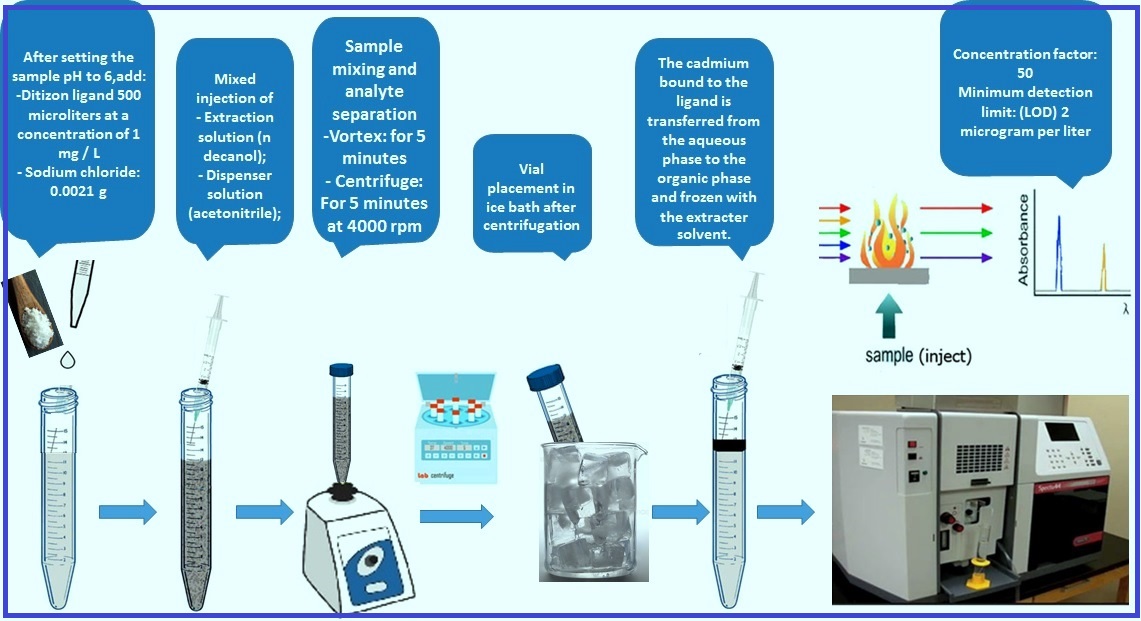Volume 10, Issue 1 (3-2020)
J Health Saf Work 2020, 10(1): 72-86 |
Back to browse issues page
Download citation:
BibTeX | RIS | EndNote | Medlars | ProCite | Reference Manager | RefWorks
Send citation to:



BibTeX | RIS | EndNote | Medlars | ProCite | Reference Manager | RefWorks
Send citation to:
Kamgou S, Abdi K, Khadem M, Heidari M, Heravizadeh O, Daneyali A et al . Development of dispersive liquid–liquid microextraction solidofied floating organic drop (DLLME SFOD) method for determination of cadmium in biological samples. J Health Saf Work 2020; 10 (1) :72-86
URL: http://jhsw.tums.ac.ir/article-1-6253-en.html
URL: http://jhsw.tums.ac.ir/article-1-6253-en.html
Somayeh Kamgou1 
 , Khosrou Abdi2
, Khosrou Abdi2 
 , Monire Khadem3
, Monire Khadem3 
 , Mahmoud Heidari4
, Mahmoud Heidari4 
 , Omid Heravizadeh5
, Omid Heravizadeh5 
 , Ali Daneyali6
, Ali Daneyali6 
 , Seyed Jamaloddin Shahtaheri *
, Seyed Jamaloddin Shahtaheri * 
 7
7

 , Khosrou Abdi2
, Khosrou Abdi2 
 , Monire Khadem3
, Monire Khadem3 
 , Mahmoud Heidari4
, Mahmoud Heidari4 
 , Omid Heravizadeh5
, Omid Heravizadeh5 
 , Ali Daneyali6
, Ali Daneyali6 
 , Seyed Jamaloddin Shahtaheri *
, Seyed Jamaloddin Shahtaheri * 
 7
7
1- 1. Department of Occupational Health Engineering, School of Public Health, Tehran University of Medical Sciences, Tehran, Iran
2- 2. Department of Nuclear Pharmaceutical Group, School of Pharmaceutical, Tehran University of Medical Sciences, Tehran, Iran
3- 3. Department of Occupational Health Engineering, School of Public Health, Tehran University of Medical Sciences, Tehran, Iran
4- 4. Department of Occupational Health Engineering, School of Public Health, Gilan University of Medical Sciences, Rasht, Iran
5- 5. Department of Occupational Health Engineering, School of Public Health, Tehran University of Medical Sciences, Tehran, Iran
6- 6. General practitioner, Department of Medicine, Department of Medicine, Tehran University of Medical Sciences, Tehran, Iran
7- 7. Department of Pathobiology, School of Public Health, Tehran University of Medical Sciences, Tehran, Iran ,shahtaheri@tums.ac
2- 2. Department of Nuclear Pharmaceutical Group, School of Pharmaceutical, Tehran University of Medical Sciences, Tehran, Iran
3- 3. Department of Occupational Health Engineering, School of Public Health, Tehran University of Medical Sciences, Tehran, Iran
4- 4. Department of Occupational Health Engineering, School of Public Health, Gilan University of Medical Sciences, Rasht, Iran
5- 5. Department of Occupational Health Engineering, School of Public Health, Tehran University of Medical Sciences, Tehran, Iran
6- 6. General practitioner, Department of Medicine, Department of Medicine, Tehran University of Medical Sciences, Tehran, Iran
7- 7. Department of Pathobiology, School of Public Health, Tehran University of Medical Sciences, Tehran, Iran ,
Abstract: (4556 Views)
Introduction: Todays, exposure to heavy metals is happened by being produced in various environmental, industrial processes. The production of metals finally results in air pollution as well as contamination in the food chain. There are harmful effects of heavy metals such as cadmium on different organs. Therefore, this study aimed to identify and quantify cadmium in biological samples using DLLME SFOD method.
Materials and Methods: Optimization of the underlying variables played a key role in the process including sample PH, chelator, extractor and disperser solvents, ion concentration, time and rate of centrifugation and extraction time. It was done by employing central composite design (CCD) of the response surface methodology. In the process of optimization, after setting a certain pH, Specific salt concentration and ditizon added to form a complex between the metal and the chelator. A mixture of extraction and dispersant solvents added to the sample. The organic and aqueous phase separations when centrifugation and vortex carried out, the sample vial transferred to a cold ice bath and the organic solvent floated on the aqueous solvent .The organic portion containing the analyte was injected into the analyzer apparatus.
Results. The results showed that variables such as sample PH, complexing solvent, extraction solvent, centrifugation effect and extraction time play an important role in the extraction of cadmium metal ion from biological samples. The optimized method with a minimum detection limit (LOD) of 2 μg / l and a concentration factor (EF) of 50 and a relative recovery (RR) of 1.06.26 used to extract cadmium from urine samples.
Conclusion. According to the pre-test results and the optimization process, they showed that in the three factors of sample PH, salt concentration and extraction solvent volume that play a more effective role in cadmium extraction by DLLME-SFOD method.
Materials and Methods: Optimization of the underlying variables played a key role in the process including sample PH, chelator, extractor and disperser solvents, ion concentration, time and rate of centrifugation and extraction time. It was done by employing central composite design (CCD) of the response surface methodology. In the process of optimization, after setting a certain pH, Specific salt concentration and ditizon added to form a complex between the metal and the chelator. A mixture of extraction and dispersant solvents added to the sample. The organic and aqueous phase separations when centrifugation and vortex carried out, the sample vial transferred to a cold ice bath and the organic solvent floated on the aqueous solvent .The organic portion containing the analyte was injected into the analyzer apparatus.
Results. The results showed that variables such as sample PH, complexing solvent, extraction solvent, centrifugation effect and extraction time play an important role in the extraction of cadmium metal ion from biological samples. The optimized method with a minimum detection limit (LOD) of 2 μg / l and a concentration factor (EF) of 50 and a relative recovery (RR) of 1.06.26 used to extract cadmium from urine samples.
Conclusion. According to the pre-test results and the optimization process, they showed that in the three factors of sample PH, salt concentration and extraction solvent volume that play a more effective role in cadmium extraction by DLLME-SFOD method.
Keywords: Dispersive liquid–liquid microextraction solidofied floating organic drop (DLLME SFOD), cadmium, biological samples.
Type of Study: Research |
Received: 2020/03/15 | Accepted: 2020/03/15 | Published: 2020/03/15
Received: 2020/03/15 | Accepted: 2020/03/15 | Published: 2020/03/15
Send email to the article author
| Rights and permissions | |
 |
This work is licensed under a Creative Commons Attribution-NonCommercial 4.0 International License. |




